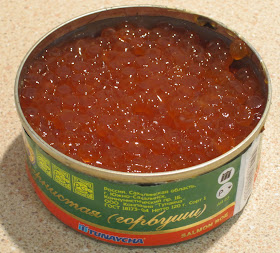While on our trip I also got to try salmon roe. In Sochi, Russia, we visited Stalin's dacha. At the end of our tour they had some tables set up with wine, water, and little pieces of bread with various toppings, including some with salmon roe.
The eggs were quite large and orange.
They were less salty and had more of a smoky, fishy taste, than the beluga caviar I tried. Later, in Yalta, Ukraine, I bought a can of salmon roe
that I brought home with me.
I tried it on a buttered cracker
and I tried it just plain on bread.
It was much more fishy than the salmon roe we had in Sochi and I'm not sure I'll even eat the whole can. It is a little too fishy for my taste. I much prefer the caviar to it. I also admit that it is hard for me not to think of the jars of salmon eggs we use as bait when we go fishing.
Salmon Roe background: Salmon roe is the internal eggs of salmon which are cured. It is less expensive than caviar and lacks the complex and rich flavor of caviar. Salmon roe is collected by harvesting female salmon shortly before spawning, when they have large egg masses. The eggs are cut out and preserved while the rest of the salmon is processed. Whole salmon roe is the most expensive because it is difficult to keep the individual eggs whole. When the eggs are broken or crushed, they decline in value. It is traditionally eaten cold and often plain so as not to mask the natural flavors. Individual eggs should crack open with a crips "pop" when pressed against the roof of the mouth and it should have a faintly salty, slightly fishy flavor. Greasy soft roe is inferior. I suspect that the salmon roe we had in Sochi was of much better quality than the salmon roe I purchased in Yalta.






No comments:
Post a Comment